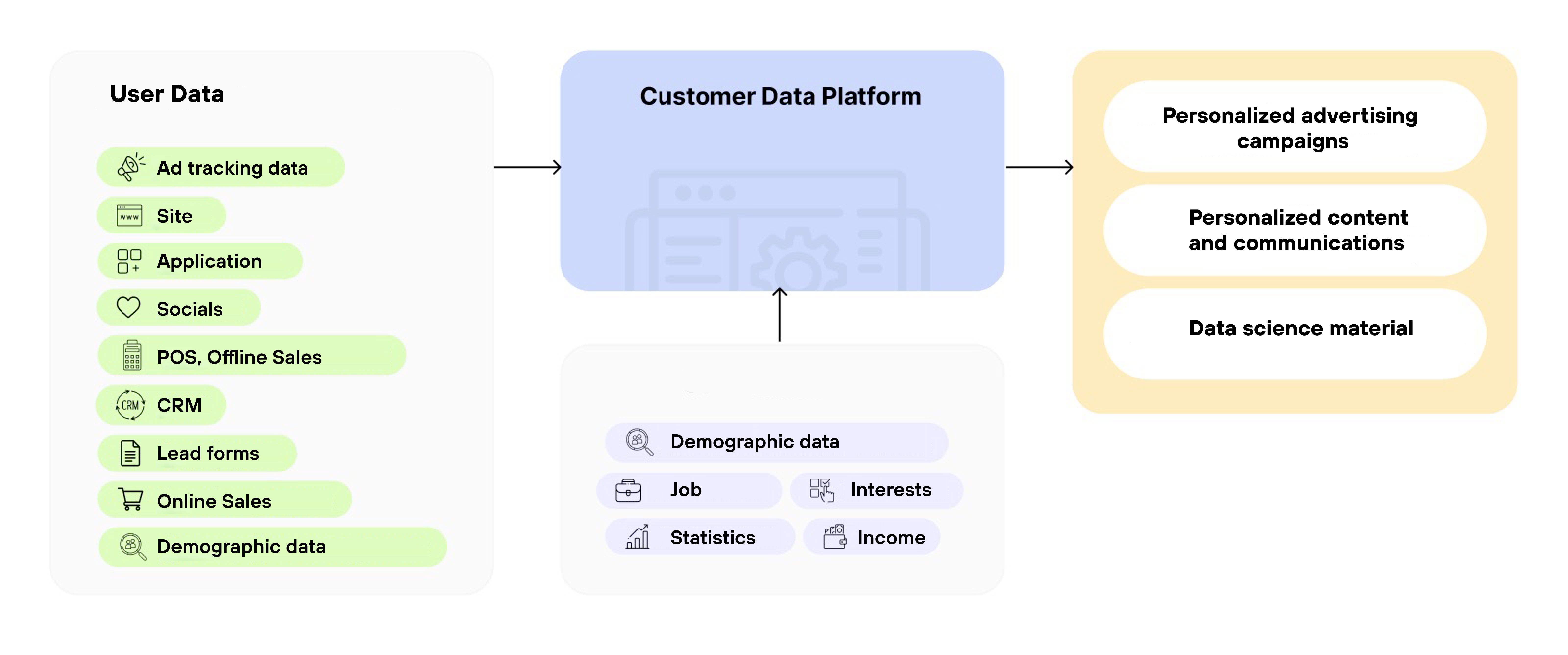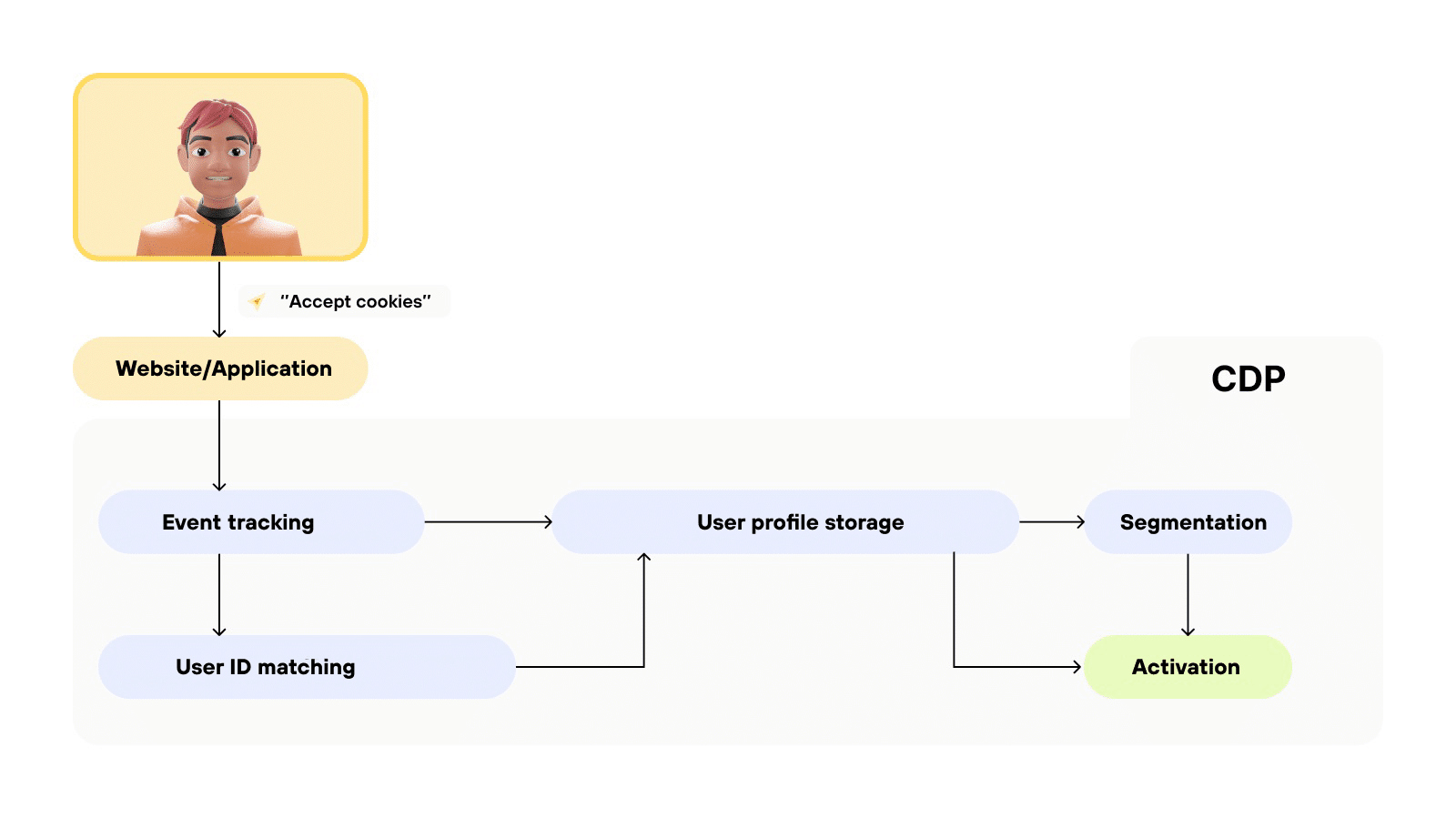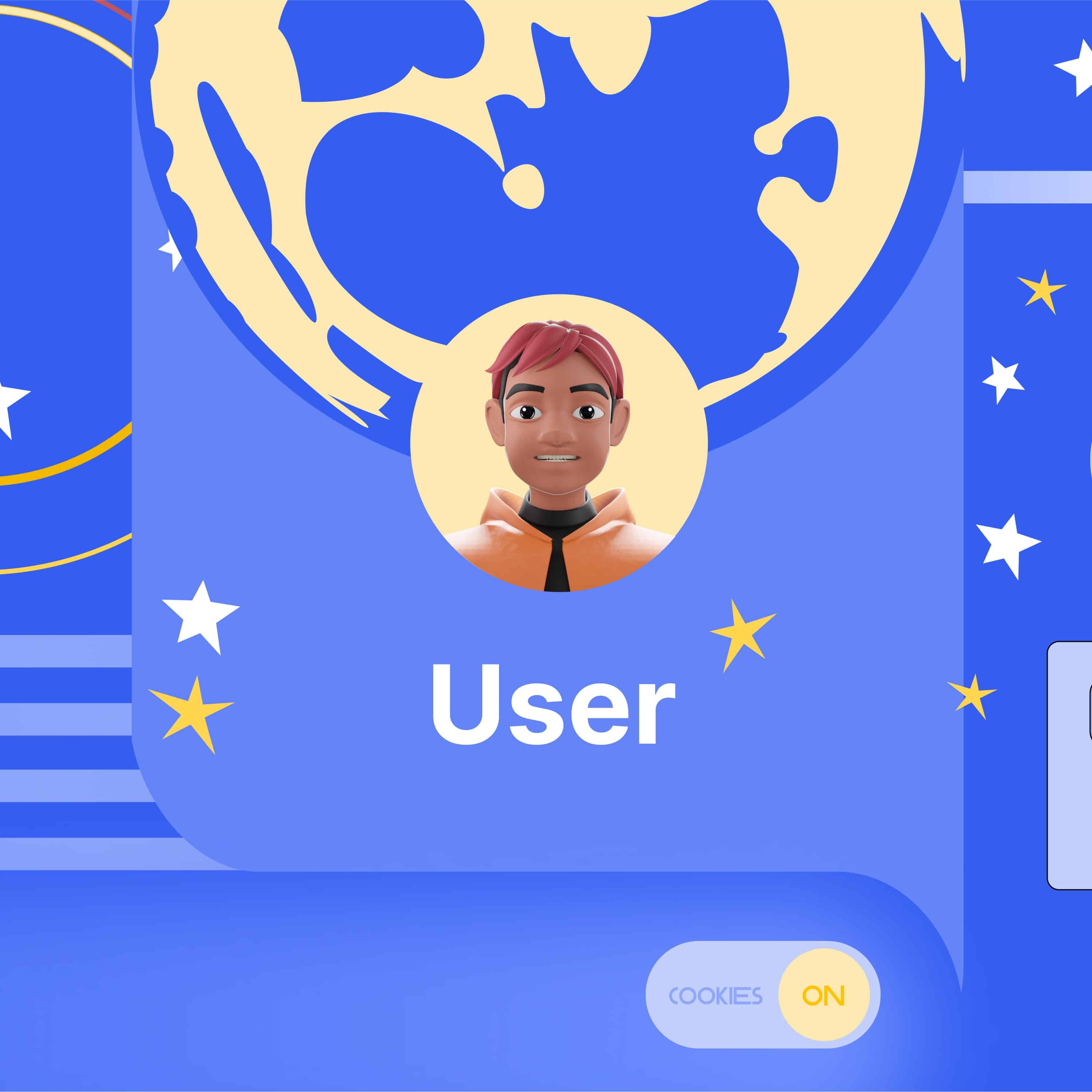Customer data platform (CDP) is a customer data platform. A system that collects data from different sources, builds user portraits, and helps personalize content and advertising.
Businesses have multiple touchpoints with customers: website, app, mail, sms, social media, offline stores. CDP accumulates information from these channels: it monitors user behavior on the website and in the app, correlates it with purchase history and activity in social networks. The platform collects this data into a single client profile, encrypts it and makes it suitable for other services.
CDP data can be used by analytics systems and advertising platforms like Google Ads. This approach helps to more accurately segment audiences and personalize content such as product recommendations, advertising, newsletters, and special offers.

CDPs work with data provided by users themselves — 1st-party cookies. Whereas most advertising platforms work with data that the site collects about users without their consent — 3rd-party cookies.
Third-party cookies are stored not only by advertisers, but also by advertising systems that have mediated advertising campaigns. Information from these cookies can be purchased by any business to customize targeted advertising. The use of third-party cookies has been legally restricted to protect users from fraudsters, and browsers have begun blocking them.
After 2023, marketers can only use 1st-party cookies — they are created and used by the site itself with the user’s consent. CDPs work mainly with such data and allow advertising campaigns without breaking the law.
In the article «Cookies: what are they, what are they for, how do they increase sales» we told in detail how third-party cookies help businesses. In another article, we also explained that third-party cookies are not the only way to get information about customers and discussed the ETag approach. It allows you to identify a user through a cache ID.
In this article, we will tell you how the CDP platform is organized, what tasks it is suitable for, and what you need to develop it.
How CDP works

- Tracks events and collects user profiles. Events are any user actions. For example, page views on a website or app, clicking on links in an email, viewing and clicking on product cards, adding and removing items from a cart or making a purchase.
As soon as a user starts interacting with any brand channel, the platform gets to work. CDP tracks events and categorizes them into profiles: it understands which user took an action and adds information to their portrait.
To get the data, the platform provides websites and applications with APIs to collect events. Collection points can be customized. For example, you can collect only contact information or track a customer’s behavior until they decide to make a purchase.
- Reconcile identifiers. An identifier helps correlate a customer’s personal data with their history of interaction with the site. They can be stable or unstable. 3rd-party cookies provide unstable identifiers. A visitor can clean them and become a new guest for the site. CDP works with User IDs, or stable identifiers — they are assigned once, change only on request, and allow for more personalized campaigns.
To match, standardize, and validate user information, the platform uses identity resolution technology. Attributes of a single user are linked together under a unique identifier. This prevents the system from creating two different profiles if the same person first visits the site from a smartphone and then from a laptop.
- Stores and updates profiles. Provides a database for user data. If a customer changes address or preferences, CDP changes this information in the repository as well.
- Segmented data. Categorizes users into groups based on characteristics that are important to a particular brand. For example, by location or propensity to make a purchase in summer or winter. Useful for more targeted marketing campaigns.
- Activates user IDs on third-party platforms. CDP acts as a smart base or repository that is integrated with other systems. They can analyze data, identify patterns, generate reports and create strategies. Data activation helps link the information in CDP to analytics systems and advertising services. The platform asks third-party systems in what form to provide them with information, prepares, encrypts data for each user and creates hashed identifiers. Then it transfers them through APIs or other integration mechanisms to third-party systems. This simplifies data management and improves the quality of analytics.
Customer data platform is usually developed on the basis of the predecessor platform — data management platform (DMP). This system mainly works with third-party cookies, so it is most often used for targeted advertising. But DMP functions can be adapted for other tasks as well. For example, to create detailed portraits of customers of an online store and recommend products to them.
OrbitSoft has its own solution, OrbitSoft DMP, which can be customized to meet the project’s objectives, including extending the set of functions to CDP. In one of our articles, we told you what clients' tasks were solved with OrbitSoft DMP. You can see cases of our other developments in the field of digital advertising by the tag «OrbitSoft advertising products».
Comparing CDP with CRM and DMP
Depending on the company’s objectives, it can use different systems to work with customer data. DMP is suitable if you need to increase the views of advertisements. CRM (customer relationship management) is a system that helps track customer interactions and automate sales. CDP is used to create personalized offers and optimize marketing campaigns based on accurate customer information.
| CDP | CRM | DMP | |
| What kind of data it works with | 1st-party + 3d-party cookies | 1st-party cookies | 3d-party cookies |
| What tasks are suitable for | — Personalize promotional offers — Collect and update a detailed user profile | — Keep a database of customer names and contacts — Analyze the sales funnel — Send mailings, sms to customers | — Personalize targeted advertising |
| For which tasks or businesses it is not suitable | Not suitable for startups and companies with less than three data sources | Collects only the information the customer left when they called the company or filled out a form on the website. Does not track user behavior | Not suitable for the development of long-term strategies |
What options for CDP can be developed
1. Basic feature set. The solution collects, stores and segments data from various sources: websites and applications, CRM, POS terminals. It then generates a unified customer profile.
2. A platform with additional functions. For example:
- forecasting — the platform analyzes online customer interactions;
- personalization — artificial intelligence is connected to the platform for data processing.
3. Platforms that provide CDP functions together with other services. Using APIs and ready integration tools, they can be connected to CRM, ERP, CMS, Telegram and VK, mobile applications.
How to connect CDP
If full customization is required, the platform is developed from scratch. This requires a team of experienced developers familiar with data processing, storage and security. They will define requirements, develop architecture and functionality, test the system and train the customer to work with it.
Off-the-shelf solutions are easier to implement. Most of these CDPs collect user data in a cloud infrastructure, are flexibly configurable and scalable. To connect the platform, you will also need the help of developers, but such a project will cost less than a custom solution.
What steps to take before starting a project:
1.Make sure there is enough data. CDP is worth connecting to a company that collects large amounts of data from three or more sources.
2.Determine what problems need to be solved. For example, you need to consolidate data into a single repository or change the application interface to make it easier to take a targeted action.
3.Clarify the features of the platform: how it works, what tools it can be integrated with, what data sources it uses, what analytics it offers, GDPR and CCPA compliance.
4.Find out what is included in the cost of the platform. Some vendors only provide access to the platform, for example on a subscription basis. You’ll need help from your development team to integrate it with your company’s systems.
5.Learn how to customize the platform and how difficult it is to use. To understand how to work in the program’s interface, you can request a demo.
OrbitSoft develops and customizes marketing platforms. We can connect a ready-made service or develop a customized solution. For example, for Beeline Programatik we created a complex product based on our own developments: OrbitSoft Ad Server, OrbitSoft SSP, OrbitSoft DSP and OrbitSoft DMP. With its help, the company shows targeted advertising to clients based on cellular operator data.
